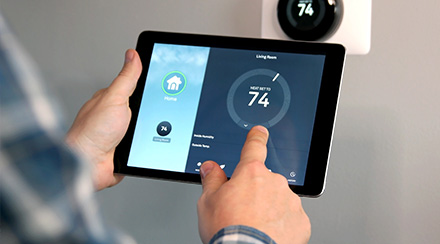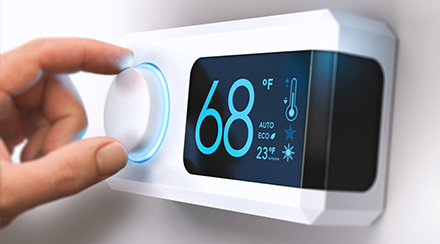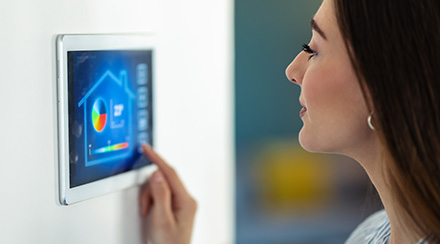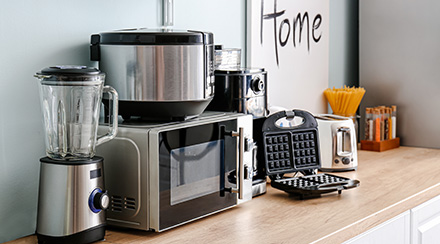What Is a Smart Thermostat and How Does It Save Energy?
We live in the era of the smart home, and one of the most useful smart home devices of them all is the smart thermostat. That’s because heating and cooling account for more than half of the energy use in the average U.S. home. It makes sense to think carefully about how to make your air conditioner and furnace more efficient, and the smart thermostat’s primary benefit is to make it easier than ever to reduce wasteful HVAC use.

What Is a Smart Thermostat?
The smart thermostat is an improvement upon the programmable thermostat, which allows users to program heating and cooling schedules so that there’s less energy waste when the home is empty or occupants are asleep.
Smart thermostats do this and more – they’re connected to the Internet, which means you can control your thermostat from anywhere using a smartphone or tablet. And most smart thermostats are supported by user-friendly apps that make it easy to create and modify heating and cooling schedules.
How Do Smart Thermostats Work?
Not all smart thermostats work exactly the same, but their common trait is that they’re designed to be connected to the Internet. So if you’re thinking about upgrading to a smart thermostat, having a reliable Internet connection is a must.
Smart thermostats communicate with your heating and cooling equipment just like traditional thermostats do. The difference is in how they communicate with you – especially when you control them using a mobile app. These apps make heating and cooling schedules quick and easy to create, which means users are more likely to use this energy-saving feature. They also allow thermostat control from anywhere, so if your schedule changes while you’re away from home, you can adjust your thermostat manually with a few taps.
Some smart thermostats have advanced features, such as the ability to “learn” your schedule and habits. If you want the most automated HVAC system possible, these learning thermostats are designed to help you reduce energy consumption without even having to think about it.
Some models use geofencing technology to recognize when you’re moving closer to home so that the temperature is optimal when you arrive, some use motion sensors to detect when your home is unoccupied and some offer detailed reports on your energy habits to help you identify more ways to conserve. Many models are compatible with home speakers so that you can control your thermostat by voice.

Do Smart Thermostats Save Money?
Smart thermostats help you save money by making it easier to use less energy when your home is unoccupied or when everyone is asleep. Nest, a smart thermostat manufacturer, published a 2015 study that claimed its thermostats offered an average savings of 10%-12% on home heating and 15% on home cooling.
Learning thermostats and other advanced models have features that help automate these energy-saving habits, but some of the simpler models may leave the energy savings entirely up to you. The key to saving money with these models is to use the convenient apps to create heating and cooling schedules, and to remember to adjust your thermostat remotely whenever you’re away from home unexpectedly.
Choosing a Smart Thermostat
Because smart thermostats are sophisticated devices and there are several models available, you should research your options carefully before you buy. Price is one factor – budget models are priced around $100, while premium models cost around $300 or more. And the major features discussed above – learning technology, geofencing, motion sensing and energy data analytics – vary from one model to the next.
Compatibility is another factor to consider. Before making a purchase, verify that your chosen smart thermostat is compatible with:
- Your HVAC equipment. This typically isn’t a problem, but if you have an older or less conventional climate control system, you might want to contact the thermostat manufacturer or consult an HVAC technician to make sure.
- Your preferred smartphone operating system. Many smart thermostats offer support and apps for both Apple and Android products, but it pays to check first.
- Your smart speaker system. If you want voice functionality, you’ll need to verify that the thermostat can communicate with your speaker model.
When it comes to reducing your energy use, a smart thermostat is a smart upgrade. It can give you an easy efficiency boost where most homeowners need it most – their energy-hungry heating and cooling equipment.
Looking for Something Specific?
Select a category to find resources for topics that interest you.
Select Category

Related Articles:

Tips for Improving Your AC and Furnace Efficiency
We share maintenance tips for your heater and AC, and home improvement tips to help you use those systems less.
Read Article
Tips for Saving on Energy in Your Home
If you’re looking to learn more about energy efficiency for home systems and appliances, we’re sharing our favorite energy-saving tips.
Read Article
What Uses the Most Electricity In a Home?
We break down what uses the most energy in your home to give you an understanding of where your energy usage goes and where energy-saving tactics can make the most impact.
Read ArticleWhat Is a Smart Thermostat and How Does It Save Energy?
We live in the era of the smart home, and one of the most useful smart home devices of them all is the smart thermostat. That’s because heating and cooling account for more than half of the energy use in the average U.S. home. It makes sense to think carefully about how to make your air conditioner and furnace more efficient, and the smart thermostat’s primary benefit is to make it easier than ever to reduce wasteful HVAC use.
What Is a Smart Thermostat?
The smart thermostat is an improvement upon the programmable thermostat, which allows users to program heating and cooling schedules so that there’s less energy waste when the home is empty or occupants are asleep.
Smart thermostats do this and more – they’re connected to the Internet, which means you can control your thermostat from anywhere using a smartphone or tablet. And most smart thermostats are supported by user-friendly apps that make it easy to create and modify heating and cooling schedules.
How Do Smart Thermostats Work?
Not all smart thermostats work exactly the same, but their common trait is that they’re designed to be connected to the Internet. So if you’re thinking about upgrading to a smart thermostat, having a reliable Internet connection is a must.
Smart thermostats communicate with your heating and cooling equipment just like traditional thermostats do. The difference is in how they communicate with you – especially when you control them using a mobile app. These apps make heating and cooling schedules quick and easy to create, which means users are more likely to use this energy-saving feature. They also allow thermostat control from anywhere, so if your schedule changes while you’re away from home, you can adjust your thermostat manually with a few taps.
Some smart thermostats have advanced features, such as the ability to “learn” your schedule and habits. If you want the most automated HVAC system possible, these learning thermostats are designed to help you reduce energy consumption without even having to think about it.
Some models use geofencing technology to recognize when you’re moving closer to home so that the temperature is optimal when you arrive, some use motion sensors to detect when your home is unoccupied and some offer detailed reports on your energy habits to help you identify more ways to conserve. Many models are compatible with home speakers so that you can control your thermostat by voice.
Do Smart Thermostats Save Money?
Smart thermostats help you save money by making it easier to use less energy when your home is unoccupied or when everyone is asleep. Nest, a smart thermostat manufacturer, published a 2015 study that claimed its thermostats offered an average savings of 10%-12% on home heating and 15% on home cooling.
Learning thermostats and other advanced models have features that help automate these energy-saving habits, but some of the simpler models may leave the energy savings entirely up to you. The key to saving money with these models is to use the convenient apps to create heating and cooling schedules, and to remember to adjust your thermostat remotely whenever you’re away from home unexpectedly.
Choosing a Smart Thermostat
Because smart thermostats are sophisticated devices and there are several models available, you should research your options carefully before you buy. Price is one factor – budget models are priced around $100, while premium models cost around $300 or more. And the major features discussed above – learning technology, geofencing, motion sensing and energy data analytics – vary from one model to the next.
Compatibility is another factor to consider. Before making a purchase, verify that your chosen smart thermostat is compatible with:
- Your HVAC equipment. This typically isn’t a problem, but if you have an older or less conventional climate control system, you might want to contact the thermostat manufacturer or consult an HVAC technician to make sure.
- Your preferred smartphone operating system. Many smart thermostats offer support and apps for both Apple and Android products, but it pays to check first.
- Your smart speaker system. If you want voice functionality, you’ll need to verify that the thermostat can communicate with your speaker model.
When it comes to reducing your energy use, a smart thermostat is a smart upgrade. It can give you an easy efficiency boost where most homeowners need it most – their energy-hungry heating and cooling equipment.
Looking for Something Specific?
Select a category to find resources for topics that interest you.
Select Category

Related Articles:

Tips for Improving Your AC and Furnace Efficiency
We share maintenance tips for your heater and AC, and home improvement tips to help you use those systems less.
Read Article
Tips for Saving on Energy in Your Home
If you’re looking to learn more about energy efficiency for home systems and appliances, we’re sharing our favorite energy-saving tips.
Read Article
What Uses the Most Electricity In a Home?
We break down what uses the most energy in your home to give you an understanding of where your energy usage goes and where energy-saving tactics can make the most impact.
Read Article






